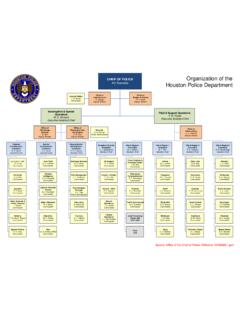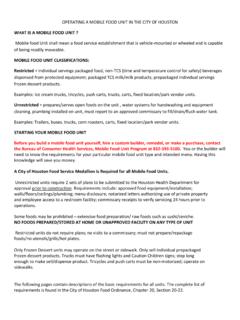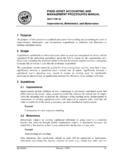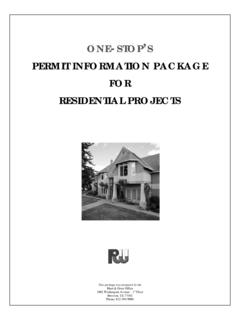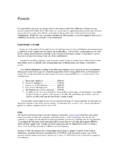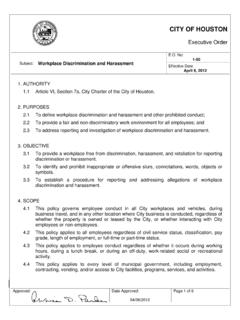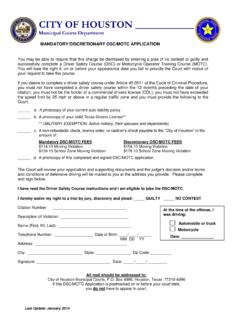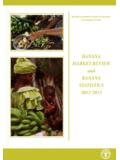Transcription of Animal Protection TF REPORT - Houston
1 REPORT of the mayor 's Animal Protection Task Force November 22, 2005 Task Force Members: Alison Smith, Chair Mary Almendarez John Chambless Margaret Gondo Carl Jackson Graciela Martinez Annie Stewart Ellen Susman Bessie Swindle 2 1. Introduction In 2004 alone, area shelters euthanized over 80,000 pets. The reason is that Houston has too many abandoned pets and an Animal welfare community whose principal solution to the problem is These animals are not wild -- in the main, they are pets whose owners neglect and then abandon them to the streets or Animal shelters because they have become inconvenient, costly, or gotten sick or older.
2 The problem is compounded by insufficient spaying and neutering, particularly in economically-disadvantaged communities where pets may roam freely and reproduce. Houston s temperate weather and ample supply of garbage allow these pets to survive, at least until they sicken, are hit by a car, or are seized by Animal control officers. Houston does too little to save these abandoned pets. Adoption rates are low, in part because there is little demand for used pets and because shelters do not do enough to find homes for pets in their care. Instead, euthanasia is the principal and depressingly rote solution. A 1997 study conducted by the National Council on Pet Population Study and Policy2 estimated that roughly 64% of the total number of animals entering Animal shelters in the United States were euthanized for some reason.
3 In contrast, Houston s Bureau of Animal Regulation and Care (BARC) euthanizes approximately 80% of the animals entering its facilities, a significantly greater rate than some other public shelters, including Austin (51%) and District of Columbia (66%). Euthanasia rates at Houston s private shelters are also high, ranging between approximately 45% and 85%. The Task Force believes that it does not have to be this way. Cities with comparable populations are substantially reducing euthanasia rates and working toward the goal of finding homes for all healthy and treatable pets arriving at area shelters. We believe that Houston should not only do likewise, but take a leading role to develop solutions for the problem of unwanted, abandoned pets in our nation.
4 1 On January 26, 2005, the mayor of the City of Houston appointed the Animal Protection Task Force to study the problems associated with the City s stray pet population and make recommendations for a community-wide initiative to better protect animals and citizens. A copy of the charge to the mayor s Animal Protection Task Force is attached as Exhibit A. 2 The mission of the National Council is to gather reliable data characterizing the number, origin, and disposition of shelter dogs and cats in the United States. For the 1997 study, out of the approximate 3,500 shelters operating in the United States, 1,000 shelters responded.
5 Their data reflected that the shelters handled million animals. 64% of the animals entering the shelters were euthanized, consisting of 56% of dogs and 71% of cats. Only 15% of dogs and 2% of cats that entered the shelters were reunited with their owners. 25% of dogs and 24% of cats that entered the shelters were adopted. See 3 2. Animal welfare community The Animal welfare community in Houston consists of one public Animal control agency, BARC, three large private, non-profit shelters, the Houston Society for Prevention of Cruelty to Animals ( Houston SPCA), Houston Humane Society (HHS), and Citizens for Animal Protection (CAP), and numerous breed rescue groups.
6 Harris County also operates public Animal control agency, Harris County Public Health & Environmental Service. A. Public shelters 1. BARC BARC is not primarily an Animal shelter -- it is the City pound. The agency is included in the Houston Department of Health and Human Services, and has historically regarded its mission as protecting the public from loose and presumptively dangerous animals. Consistent with its historical mission of disposing of unwanted pets, it is located in an out of the way, industrial area of Houston some six miles north of downtown. No signs on the freeway or elsewhere direct visitors to the facility and it is difficult to find.
7 BARC s principal kennel facility is old, consisting of extremely small, cramped cages for animals similar to those used in medical research labs. BARC obtains its pets primarily by seizing dogs and cats that are at large in the community. Some of these animals may pose a threat to community; however, most are simply Pets apprehended by Animal control officers (ACOs) in the field totaled 22,713 in fiscal year 2005. In addition, Houstonians turn in their pets to BARC at a rate of approximately 300 a month, totaling about 3,600 owner abandonments to BARC per year. BARC euthanizes the large majority of pets it receives. The Task Force could not obtain reliable historical statistics from BARC, because, until November 2004, BARC did not track total Animal intake.
8 However, using BARC s disposition rates, we derived an approximate 80% euthanasia rate. In fiscal year 2005, for example, BARC received approximately 26,243 animals and euthanized 21,214, or about 80% of them. Correspondingly, BARC adopted out 1,463 or approximately , returned to their owners 1,579 or approximately , and transferred to other locations 1,698 or approximately 8%. Statistics for the period 2000 to 2005 follow:4 3 Until recently, BARC ACOs also picked up pets from owners who desired to voluntarily relinquish them to the pound. This practice was discontinued several years ago in response to a manpower shortage and a recommendation from the National Association of Animal Control Officers.
9 4 Attached as Exhibit B are BARC s Monthly Activity Reports for fiscal years 2000-2005. 4 2000 2001 2002 2003 2004 2005 Animal intake5 27,969 27,481 24,336 21,433 23,247 26,243 Euthanasia 23,396 22,161 19,378 16,475 18,107 21,214 Adoption 445 636 585 908 937 1,463 Redemption 1,725 1,945 1,895 1,490 1,350 1,579 Transfer 1,488 1,654 1,699 1,553 1,914 1,698 BARC explains its high euthanasia rate on the ground that the overwhelming majority of the pets it receives are not adoptable. But the Task Force found that BARC has no policy guiding the distinction between adoptable and unadoptable pets, and instead has a strong bias in favor of euthanasia.
10 In other words, BARC s conclusion that a pet is unadoptable is essentially a policy choice to euthanize the overwhelming percentage of pets delivered to its facility. The Task Force was surprised to learn that BARC euthanizes off the truck approximately 40% of the animals that the ACOs deliver to the facility, meaning that these pets are immediately euthanized and never have the chance for either owner redemption or adoption. BARC explained that most of these pets have mange or ringworm and thus pose a threat to the shelter However, this explanation is unsatisfactory. Diagnosis of mange and ringworm cannot be made just by looking at the pet7 and both are non-serious skin conditions that a lost pet could easily acquire just because he has been living in the streets.
